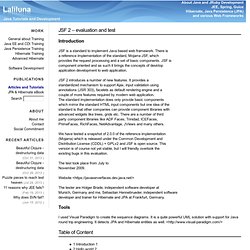

How to export data from database to excel sheet by using java in standalone project. Inovative Items. JSF 2 - evaluation and test. Introduction JSF is a standard to implement Java based web framework.

There is a reference implementation of the standard, Mojarra JSF, which provides the request processing and a set of basic components. JSF is component oriented and as such it brings the concepts of desktop application development to web application. JSF 2 introduces a number of new features. It provides a standardized mechanism to support Ajax, input validation using annotations (JSR 303), facelets as default rendering engine and a couple of more features required by modern web application.
We have tested a snapshot of 2.0.0 of the reference implementation (Mojarra) which is released under the Common Development and Distribution License (CDDL) + GPLv2 and JSF is open source. The test took place from July to November 2009. Website < Tools I used Visual Paradigm to create the sequence diagrams. Hello world The hello world application intends to show how complex it is to setup a simple application. Requirements: <? <? <? A look at Java 7's new features.
There are a number of features in Java 7 that will please developers.

Things such as strings in switch statements, multi-catch exception handling, try-with-resource statements, the new File System API, extensions of the JVM, support for dynamically-typed languages, the fork and join framework for task parallelism, and a few others will certainly be embraced by the community. Below I outline the features and provide examples where appropriate. A zip file containing code snippets used in this post can be downloaded here. Language enhancements Java 7 includes a few new language features via Project Coin.
Diamond Operator You may have noted on many occasions your IDE complaining of types when working with Generics. Map<String, List<Trade>> trades = new TreeMap<String, List<Trade>> (); The not-so-nice thing about this declaration is that we must declare the types on both the sides, although the right-hand side seems a bit redundant. Map<String, List<Trade>> trades = new TreeMap <> (); 1. JSF Tags. JSF Central - Articles & Books. JSH(jsf+spring+hibernate)
Online IDE & Debugging Tool >> C/C++, Java, PHP, Python, Perl and 40+ compilers and intepreters. Jsf thread batch processing how to. Whenever I need to perform a long-running function in Enterprise Java, I use what I call a "null servlet".

A null servlet is a servlet that has no action processors (doGet, doPost). Instead, it simply has an init() method that spawns a thread or threads to run the long-running processes in. Most commonly, this thread (or a dispatcher, if there are multiple threads) will pull requests from a work queue, and the UI part of the webapp will place the requests into the work queue. I may include a request monitoring component as well. Since there are multi-threading concerns here, the work queue is a synchronized data structure. UI requests may not spawn threads themselves, and it's usually not safe for monitoring components such as session listeners to do so either.
One final caveat. Use or example.
Notes. Faces. Google.